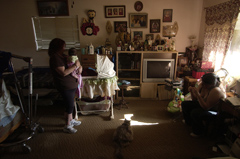
Foreclosure rate up five times
Juanita and her family purchased their dream home in 1974, in
Hollister. After much hard work and saving, the family had acquired
enough capital to put a down payment on a home and had no problem
making the payments, at first.
Foreclosure rate up five times
Juanita and her family purchased their dream home in 1974, in Hollister. After much hard work and saving, the family had acquired enough capital to put a down payment on a home and had no problem making the payments, at first.
Juanita agreed to be interviewed on the condition that her real name not be identified in the story.
Bills can sometimes be unexpected. Juanita refinanced her home several times.
The last time she went to a lending agency, she was informed that the family could not refinance again, because the payments would be more than the family made in income.
So Juanita and her family went to another private lender. They got the money, but that’s when the problems started.
“He filled out all the paperwork for us and didn’t give me any copies of anything,” Juanita said. “Suddenly [the lender] is missing payments and the banks are sending me letters.”
Then the family received a notice of foreclosure on their home earlier this month. The bank would re-possess the house if the family could not come up with $25,000 in 30 days.
Juanita and her family are not alone. Their problem is one that stretches throughout California, as homeowners all over the state are left scratching their heads as their homes are sold out from underneath them.
In San Benito County, the foreclosure rate has exploded over the last year. According to Carl Skow, of Pinnacle Finance Company and 2006-2007 president of the Greater Monterey Bay Area chapter of the California Association of Mortgage Brokers, the number of homes repossessed by banks was five times greater this year than last year. The number of foreclosures in San Benito in 2006 was 17 and the number so far in 2007 is 71. Three alone happened last week.
The number of default notices sent to California homeowners last quarter increased to its highest level in almost 10 years, the result of flat appreciation, slow sales, and post teaser-rate mortgages, a real estate information service reported.
Part of the reason foreclosure rates are exploding is because housing has reached a plateau, Skow said. People are purchasing homes and re-selling them, without equity for the same, if not less, than what they paid for them.
“So if you purchased a house at $650,000 at 100-percent financing and you’re able to sell it for what you paid it still ends up costing more because you need to pay the realtor fees and the closing costs,” Skow said. “Plus there are pre-payment penalties if the borrower pays back the loan early. So even if you make back what you paid for the house, you might end up paying an additional $60,000 in fees after all is said and done. When houses were appreciating that was not a problem, but that’s not happening now.”
Greg Dolan, owner of Shamrock lending agreed.
“The bottom line is that two or three years ago everyone was qualified, but now the banks are doing away with all these loans,” Dolan said. “People are literally walking away from homes they bought three years ago, because they can’t afford to make the payments. They played the game and purchased an overpriced home and went with a 100 percent financed, no-equity loan and now they go to re-finance and they can’t get a lower rate. There’s nothing they can do. They simply walk away.”
This isn’t the magic bubble bursting; it’s just market fluctuation, according to Dolan. The problem is that buyers took out loans that they were not clear on the terms of.
The two-year fixed interest loans that lenders were issuing left and right two years ago are all now starting to mature. So a two-year fixed interest loan is now turning into an adjustable interest loan, Skow said.
While the monthly payments were manageable for the first two years of the loan, when the loan matured and the interest rate changed, people were suddenly stuck with a monthly payment they couldn’t afford. At the same time they couldn’t refinance because their credit scores weren’t high enough, and the value of the home had either stayed the same or decreased.
“People get into this situation where they owe more and more and they can’t get their heads above water,” Dolan said. “So now every two months they owe more and more. The banks are basically taking the legs out from under people. People come and see me and there’s nothing I can do. I feel for them, but my hands are tied.”
Juanita doesn’t know what her family will do. They had been saving to make the payment, but there is still no way they can afford to pay $25,000 to the bank.
“We’ve talked about maybe declaring bankruptcy. Maybe that way they’ll let us keep our house,” Juanita said. “Otherwise I don’t know what we’ll do.”









